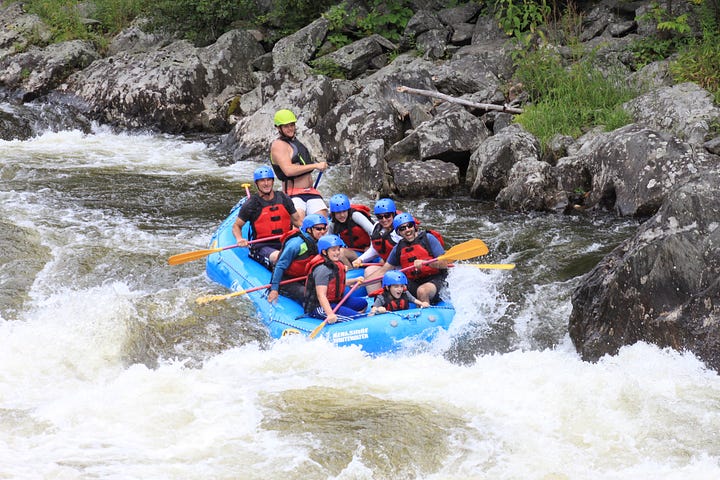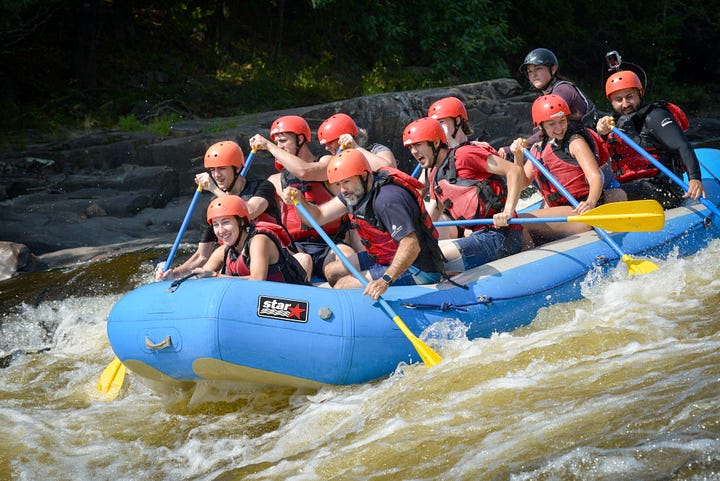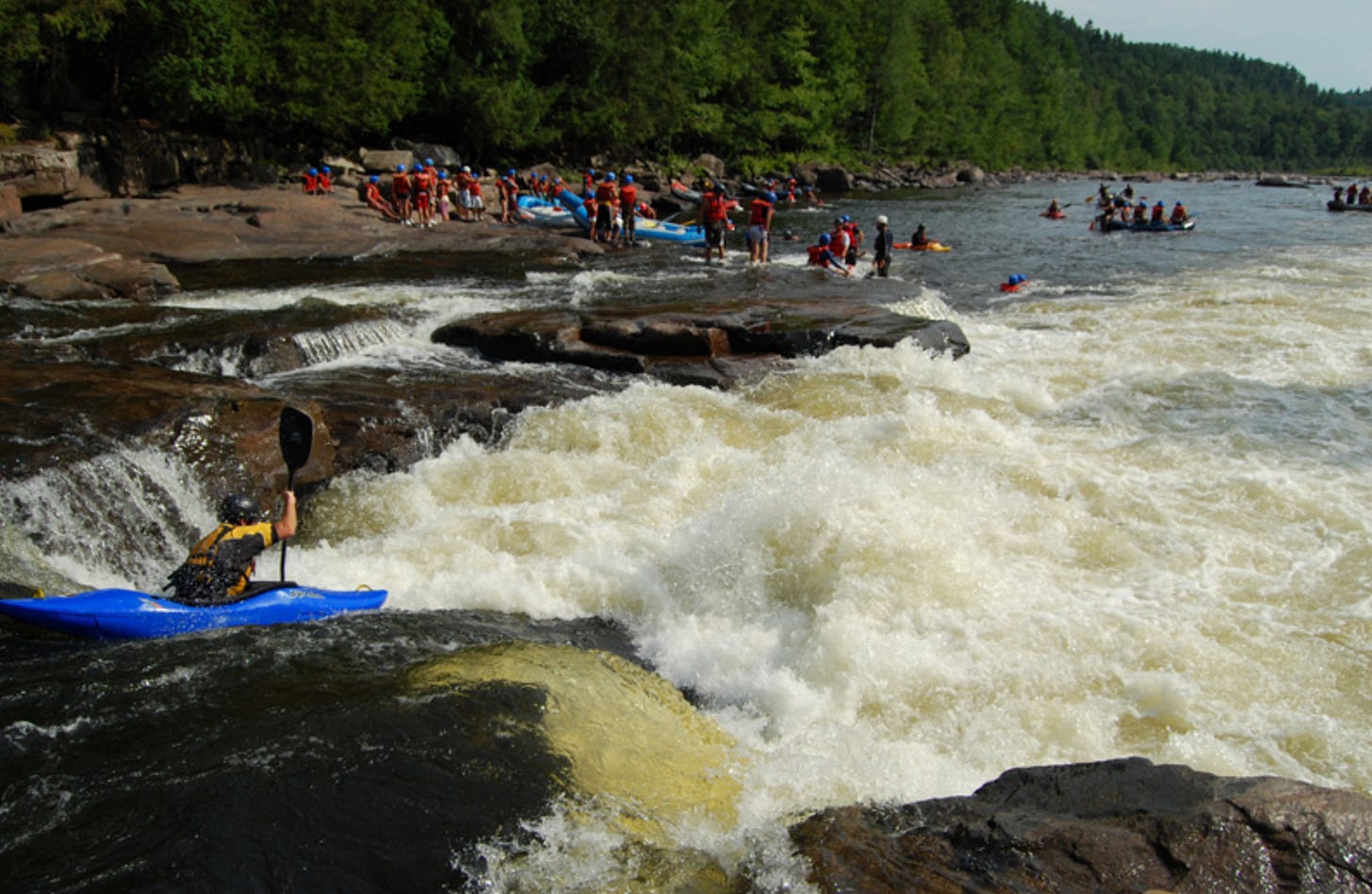A group project I loved
And the power of time-and-place-bound connections


First photo by Zoar Outdoor, second photo by Propulsion Rafting.
This past week, we went whitewater rafting. D and I had gone several times before we had kids and several years ago, we had taken the boys on a relatively tame trip in Western Massachusetts. My first trip was in April of my first year in college with a bunch of friends on the New River in West Virginia. Because it was April, the river was swift and the rapids fast, but the temperature was still quite cold and we had to wear wet suits and wool socks, and switch to a different river, as we would have gotten hyperthermia if we fell in on the original river. We did an overnight trip, and that night, after a delicious dinner cooked by our river guides, as many of us as could fit (if my memory serves me, it was six or seven people in a four-person tent) piled into one tent to try and generate as much heat as possible. It was cold. Cold enough that snow fell overnight. We got up the next day, the ground crunchy with sparkling frost crystals and a light coating of snow, and wiggled our way into freezing cold, stiff wetsuits and hit the river again. It was exhilarating. And so cold. Several years later, we would head up to Maine and raft down the Kennebec River. We did this trip a few times and despite being about 900 miles north of the New River, the Maine water in the summer was significantly warmer than the West Virginia river in early April.
I forgot how much of a thrill ride rafting is. Perhaps because I am older, my body less forgiving and agile, now heavier and slower, I had a bit more worry, a bit more fear. After paddling through our first rapid, our skilled and adaptable guide asked if anyone minded getting wet. I thought about hopping out. I hesitated. I almost got out, to be honest, but decided I didn’t know when (or if) I would find myself on a raft again and went for it. We headed into the rapid for a third time, and the raft flipped. I had somewhere between 5-15 seconds of sheer panic—the raft above me, my body being pulled under by the quickly moving current—before my PFD (personal flotation device, formerly known as a life preserver or life jacket) did its job and I bobbed up above the surface of the water. I remembered to put my legs out in front of me and quickly floated out of the rapid and into the stiller water, easily able to get back into the raft. Our guide had beached it on a large flat rock, making stepping back into the raft relatively effortless. Once we were all back in the boat, we learned that the flip had been the goal—a slightly terrifying, definitely thrilling experience. While we had several more encounters with rapids, we would not flip the raft again. We had times when our nimble and surefooted guide pulled tightly on someone’s PFD straps and kept them in the boat, saving them from another trip into the rapids. At one point, she called out “down down down,” which meant that we were to sit on the bottom of the raft. My foot was firmly wedged beneath the thwart in front of me and I couldn’t pull it loose. I struggled to get my foot out, the rest of my body on the bottom of the boat. Again, probably only 5 to 10 seconds, but it felt like an eternity before I wriggled my foot free and took my place on the floor as we bumped and spun in the rapidly moving current. The only time anyone was in the river after that was at the several spots where we willingly fell backward into the refreshing and relatively still river for a swim.
For several hours, we were focused solely on the task at hand—listening to our delightful river guide, Kimberly, and putting paddles in to go forward or back according to her command. No phones, no smart watches, nothing to take us away from the moment in front of us. Bracing ourselves as we saw whitewater ahead, digging paddles in and bumping along through smaller rapids. I reflected on the different ways this singular experience was playing out for not just my boys and D, but the people on the other five or six rafts that were floating with us. I could see L, pushing himself to get every drop of excitement and adrenaline from the ride down the river. Doing flips off the back of the raft when we were in still water. A big smile on his face when he took the mermaid seat in the front of the boat and was continuously doused with water as we hit rapids. Z, willing himself through an experience about which he was not super enthused. He did not want to fall in the water, taking the out to sit on the rocks after our first rapid encounter, thus avoiding the raft flip. He did muscle through the rest of the trip and I hope he felt a sense of accomplishment at that. I felt guilty, not having remembered that water is not a comfort zone for him, and both D and I told him how much we appreciated him coming along and taking part despite this. I even caught a few smiles as we went through smaller rapids. M had determination on his face, and I would have never known that he, too, was filled with trepidation about the possibility of falling. He had managed the flip easily and was up in front with his brother and D, never coming to the back where Z and I held steady. After the trip was over, he shared that he was glad he had done it and he enjoyed it more now that it was over. Who knew how the other 50 or so folks on the river that day felt about their trips down the Rouge River. Whether they swelled with the adrenaline rush, wished for more fierce rapids than the August river held, were surprised by the jolts of thrill and anticipation, loved being on the river, or perhaps had been cajoled into joining by friends, I hope they all had some version of my own—relishing the present moment, the lack of digital distraction, the necessity of being in the here and now, focused on the activity of moving forward through the water and having fun while doing it.
When the river was relatively calm, we chatted with the other folks in the raft. Our family was joined by a group of friends in their mid to late 20s who were all baristas together. I was mostly in the back of the raft, as this was deemed the space where one was least likely to fall out, so got to chat a bit with our guide. She was a self proclaimed river rat—a whitewater enthusiast—who had spent the past 10 years traveling the world and guiding people in kayaks and rafts through whitewater. She shared that it was getting harder and harder to attract people to whitewater rafting. Younger people, 20-35 years old, had less interest in group activities and were not showing up in the numbers rafting outfits had seen in the past. Prices had held steady over the past 10 years—vacationers and locals alike not willing to pay more—making it harder and harder for someone to earn a living as a river guide. She shared that insurance was squeezing so much out of these small operations, run by people who were passionate about the river and sharing it with others. She had another full-time job to pay the bills with enough flexibility to hop in her car and drive the 60-75 minutes to basecamp when they needed another guide. She was personable and fun, her zeal and knowledge of the river evident. I looked out at the river, the juts of rocks visible with the lower water level that comes with early August. I thought what it must be like to know the way the current moved around these rocks, how that changed with rainfall. To understand how the raft maneuvered around these rocks, how the current pulled and pushed a raft. Then add to that commanding a boat full of people of different skill levels and weights and attention spans and fear. I thought of how well I knew the woods near my house—a place I had spent thousands of hours over the past five years. And yet, with each season—as the trees filled out in spring, the weeds grew up high and thick in summer, the brush started to dry out and fall as the leaves above them exploded into fiery colors, and finally, when the trees were trunk and branches with no leaves hanging on—I had to reorient myself to the woods, almost as if I was entering a new forest. I imagined that spending days on the river, guiding people down, she learned to make those adjustments much more quickly. So much skill, so much knowledge, so much understanding that could come from being with the water, learning how it moved and rushed, swirled and spun. I knew that rafting, much like skiing, was a sport that held inherent risk. You didn’t know if this could be the time a current caught you in just the wrong way and hit a part of you against a rock. Or a fall from the boat would result in a foot trapped in a crevice. A watch band on a branch underwater. So many possibilities for things to go wrong. And yet, most of the time, the vast majority of the time, things went just fine. The panic lasted a few seconds, the release came quickly. With someone as skilled as our guide, my worry was as little as it could be. She knew this river. She loved this river. She respected its strength.

Twenty-five years ago, political scientist, Robert Putnam, described people in the U.S. being less engaged in civic life and social connection, leading to a decline in social capital and community in his groundbreaking work, Bowling Alone: The Collapse and Revival of American Community (2000). Former U.S. Surgeon General, Vivek Murthy, described loneliness and isolation as an epidemic on par with tobacco use in the United States following the COVID pandemic. Research and life experience has shown us time and time again that what gets us through the hard things that life brings from disappointment to heartache to loss is our connection to each other. Our family and friends provide us with the emotional, tangible, and structural support we need to make it through a cancer diagnosis and treatment, exit an abusive relationship, deal with the gutting heartache of losing a friend or a parent, help our child navigate being left out or bullied, and so many other things we face in this life. We are social creatures. We need each other. We require and crave connection. During COVID, when our world shut down, we learned about how desperately we need microconnections—smiling at the person who inadvertently stepped in front of your cart in the grocery store aisle, giving an understanding look to the parent whose toddler has thrown themselves on the floor of the take-out place testing out just how loud they can cry, having a conversation with the older woman who stops you on your walk to ask if you have directions, sharing details about your dogs when you encounter another dog owner on your nightly walk. All of these small interactions add up, provide us with a continued sense of community, belonging, a sense that people are kind.
Almost 20 years ago, I wrote my doctoral dissertation on informal support network—family and friends—and their role in helping women leave violent relationships. I talked with sisters, friends, parents who had a loved one who was being abused by her partner. They talked about the process of realizing and then confirming that their sister or daughter or friend was being emotionally and physically hurt by their partner. They shared the process they went through of trying to support her, most of them trying to help her leave the relationship. This process was heartbreaking and challenging and exhausting. Most of them were no longer in regular contact with the person who had been experiencing violence. The long process of leaving, with most individuals leaving six to eight times before getting out of the relationship for good, drained the relationship of its connection. Their stories were full of agony and doubt, wondering if they had done enough, if they could have done more. They were often the only person she confided in, isolation being a hallmark of abusive relationships. As part of my research, I read everything I could about why social scientists thought people did or did not intervene when they learned about or witnessed abuse. Sadly, as a country, we do not have much trust in our neighbors. In 1960, 55% of people in the US agreed with the statement “most people can be trusted.” By 1995, less than 35% of people agreed. The most recent data are from 2023 and the percentage remains around 36% (Pew Research, obtained at https://www.pewresearch.org/2025/05/08/americans-trust-in-one-another/). When we don’t trust each other, we don’t feel as obligated to help each other out in small ways—such as bringing in our neighbor’s trash cans or shoveling a neighbor’s walk—let alone bigger ways like supporting a friend trying to leave an abusive relationship. Whatever our thoughts about our current political climate, most of us feel our country is deeply divided. We feel distant and separate from whole groups of people.
It hurts.
All of us.
I felt a connection to the young people on our raft. I spent an afternoon with them, an afternoon that I will remember, I will treasure. Mostly because it was a day with my boys, with D, doing an activity together on a beautiful river, but also because we met five new people and all of us worked together to make it down the river safely and have some fun. We ended up eating dinner at the same restaurant as the group of friends on our raft—a local poutine and ice cream place, the cheese made right there at the restaurant. We smiled when we saw each other. When I was walking to our car after getting ice cream, they had just gotten in their car and yelled out a goodbye. We had a connection. I don’t know much about them beyond their connection to each other and that they were from Ottawa. But I could tell that they were kind. That they enjoyed each other’s company. They love the outdoors. They are adventurous. That they trust other people. That they also enjoyed spending the afternoon with us.
I will likely never see our guide, Kimberly again. She will go on living her life, guiding other people down the river, more daring and thrill-seeking than I. She will hoist many more people back into the raft after they fall over intentionally or unintentionally. She will continue to gauge the skill and enthusiasm level of her rafters and make decisions about what level of excitement to engage. She will continue to offer her clear and careful instructions about what exactly needs to be done to get through technical rapids. She will offer people an out for skipping a rapid, sensitive to providing an experience that meets all levels. She will offer her passion and her understanding of the river to hundreds of other people. I spent a few hours with her on a warm August afternoon. She pulled me up into the raft, she made sure I was in the spot in the raft that best fit my comfort level. She pulled me down to the floor to keep me in the raft and not tumbling out. She shared her love of the river, of whitewater, of guiding people. She was kind. She was generous. She offered her connection to all of us on that raft. And my life is better for knowing her.
I hope we figure out a way back to connection. I hope we relearn that a day spent rafting or hiking or walking or sitting by a lake or on a beach or in someone’s kitchen or backyard brings us so much more than staring at a screen. I hope we realize that when we do something together, as a group, whether it is with people we know or people we come together with just for this activity, it not only brings us that connection, but reminds us that people are generally lovely and kind and generous. That connecting for an afternoon or an hour or a brief smile is almost always worth it. That with the support of each other, we can do so much. We can overcome fears, we can learn new skills, we can create art, we can get through hard things.
We can connect.
Because at the end of the day, that is what makes life bearable.
So get out there. Raft down a river. Hike a mountain. Walk around a pond or a lake. Jump in. And do it with other people. Friends. Loved ones. People you just met.
You may just meet your own Kimberly, have your own adventure down the Rouge River with your young adult children and your husband and four baristas.
I hope you do.
Image from http://www.liquidlore.com/quebec/rouge-7-sisters/
All photos were taken by the exceptional Dana Giuliana, unless otherwise noted.
All mistakes are mine and your confirmation that the words came from my brain, not AI.
Thanks for spending some of your day reading this post. I hope it resonated. Periplum of motherhood and other wonderings is free. If you enjoy reading, please share it with friends!



